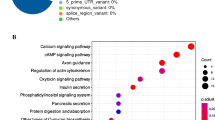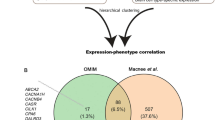Abstract
The Noda epileptic rat (NER) exhibits generalized tonic–clonic seizures (GTCS). A genetic linkage analysis identified two GTCS-associated loci, Ner1 on Chr 1 and Ner3 on Chr 5. The wild-type Ner1 and Ner3 alleles suppressed GTCS when combined in double-locus congenic lines, but not when present in single-locus congenic lines. Global expression analysis revealed that cholecystokinin B receptor (Cckbr) and suppressor of tumorigenicity 5 (St5), which map within Ner1, and PHD finger protein 24 (Phf24), which maps within Ner3, were significantly downregulated in NER. De novo BAC sequencing detected an insertion of an endogenous retrovirus sequence in intron 2 of the Phf24 gene in the NER genome, and PHF24 protein was almost absent in the NER brain. Phf24 encodes a Gαi-interacting protein involved in GABAB receptor signaling pathway. Based on these findings, we conclude that Cckbr, St5, and Phf24 are strong candidate genes for GTCS in NER.




Similar content being viewed by others
References
Amano S, Ihara N, Uemura S, Yokoyama M, Ikeda M, Serikawa T, Sasahara M, Kataoka H, Hayase Y, Hazama F (1996) Development of a novel rat mutant with spontaneous limbic-like seizures. Am J Pathol 149(1):329–336
Beinfeld MC, Meyer DK, Eskay RL, Jensen RT, Brownstein MJ (1981) The distribution of cholecystokinin immunoreactivity in the central nervous system of the rat as determined by radioimmunoassay. Brain Res 212(1):51–57
Fritschy JM, Meskenaite V, Weinmann O, Honer M, Benke D, Mohler H (1999) GABAB-receptor splice variants GB1a and GB1b in rat brain: developmental regulation, cellular distribution and extrasynaptic localization. Eur J Neurosci 11(3):761–768
Gaillard S, Lo Re L, Mantilleri A, Hepp R, Urien L, Malapert P, Alonso S, Deage M, Kambrun C, Landry M, Low SA, Alloui A, Lambolez B, Scherrer G, Le Feuvre Y, Bourinet E, Moqrich A (2014) GINIP, a Gαi-interacting protein, functions as a key modulator of peripheral GABAB receptor-mediated analgesia. Neuron 84(1):123–136
Gassmann M, Bettler B (2012) Regulation of neuronal GABAB receptor functions by subunit composition. Nat Rev Neurosci 13(6):380–394
Gohring I, Tagariello A, Endele S, Stolt CC, Ghassibe M, Fisher M, Thiel CT, Trautmann U, Vikkula M, Winterpacht A, FitzPatrick DR, Rauch A (2010) Disruption of ST5 is associated with mental retardation and multiple congenital anomalies. J Med Genet 47(2):91–98
Goldberg EM, Coulter DA (2013) Mechanisms of epileptogenesis: a convergence on neural circuit dysfunction. Nat Rev Neurosci 14(5):337–349
Hanaya R, Sasa M, Kiura Y, Ishihara K, Serikawa T, Kurisu K (2002) Epileptiform burst discharges in hippocampal CA3 neurons of young but not mature Noda epileptic rats (NER). Brain Res 950(1–2):317–320
Kiura Y, Hanaya R, Serikawa T, Kurisu K, Sakai N, Sasa M (2003) Involvement of Ca2+ channels in abnormal excitability of hippocampal CA3 pyramidal cells in noda epileptic rats. J Pharmacol Sci 91(2):137–144
Kuramoto T, Kuwamura M, Tokuda S, Izawa T, Nakane Y, Kitada K, Akao M, Guenet JL, Serikawa T (2011) A mutation in the gene encoding mitochondrial Mg2+ channel MRS2 results in demyelination in the rat. PLoS Genet 7(1):e1001262
Li H, Durbin R (2009) Fast and accurate short read alignment with Burrows–Wheeler transform. Bioinformatics 25(14):1754–1760
Li H, Handsaker B, Wysoker A, Fennell T, Ruan J, Homer N, Marth G, Abecasis G, Durbin R, Genome Project Data Processing S (2009) The Sequence Alignment/Map format and SAMtools. Bioinformatics 25(16):2078–2079
Liska F, Gosele C, Rivkin E, Tres L, Cardoso MC, Domaing P, Krejci E, Snajdr P, Lee-Kirsch MA, de Rooij DG, Kren V, Krenova D, Kierszenbaum AL, Hubner N (2009) Rat hd mutation reveals an essential role of centrobin in spermatid head shaping and assembly of the head-tail coupling apparatus. Biol Reprod 81(6):1196–1205
Liu Z, Wang F, Fischer G, Hogan QH, Yu H (2016) Peripheral nerve injury induces loss of nociceptive neuron-specific Gαi-interacting protein in neuropathic pain rat. Mol Pain. doi:10.1177/1744806916646380
Maihara T, Noda A, Yamazoe H, Voigt B, Kitada K, Serikawa T (2000) Chromosomal mapping of genes for epilepsy in NER: a rat strain with tonic-clonic seizures. Epilepsia 41(8):941–949
Maksakova IA, Romanish MT, Gagnier L, Dunn CA, van de Lagemaat LN, Mager DL (2006) Retroviral elements and their hosts: insertional mutagenesis in the mouse germ line. PLoS Genet 2(1):e2
McKenna A, Hanna M, Banks E, Sivachenko A, Cibulskis K, Kernytsky A, Garimella K, Altshuler D, Gabriel S, Daly M, DePristo MA (2010) The Genome Analysis Toolkit: a MapReduce framework for analyzing next-generation DNA sequencing data. Genome Res 20(9):1297–1303
Miller KK, Hoffer A, Svoboda KR, Lupica CR (1997) Cholecystokinin increases GABA release by inhibiting a resting K+ conductance in hippocampal interneurons. J Neurosci 17(13):4994–5003
Nishitani A, Tanaka M, Shimizu S, Kunisawa N, Yokoe M, Yoshida Y, Suzuki T, Sakuma T, Yamamoto T, Kuwamura M, Takenaka S, Ohono Y, Kuramoto T (2016) Involvement of aspartoacylase in tremor expression in rats. Exp Anim 65(3):293–301
Noda A, Hashizume R, Maihara T, Tomizawa Y, Ito Y, Inoue M, Kobayashi K, Asano Y, Sasa M, Serikawa T (1998) NER rat strain: a new type of genetic model in epilepsy research. Epilepsia 39(1):99–107
Perez de la Mora M, Hernandez-Gomez AM, Mendez-Franco J, Fuxe K (1993) Cholecystokinin-8 increases K+-evoked [3H]γ-aminobutyric acid release in slices from various brain areas. Eur J Pharmacol 250(3):423–430
Serikawa T, Yamada J (1986) Epileptic seizures in rats homozygous for two mutations, zitter and tremor. J Hered 77(6):441–444
Serikawa T, Kuramoto T, Hilbert P, Mori M, Yamada J, Dubay CJ, Lindpainter K, Ganten D, Guenet JL, Lathrop GM et al (1992) Rat gene mapping using PCR-analyzed microsatellites. Genetics 131(3):701–721
Serikawa T, Mashimo T, Takizawa A, Okajima R, Maedomari N, Kumafuji K, Tagami F, Neoda Y, Otsuki M, Nakanishi S, Yamasaki K, Voigt B, Kuramoto T (2009) National bioresource project-rat and related activities. Exp Anim 58(4):333–341
Shao H, Sinasac DS, Burrage LC, Hodges CA, Supelak PJ, Palmert MR, Moreno C, Cowley AW Jr, Jacob HJ, Nadeau JH (2010) Analyzing complex traits with congenic strains. Mamm Genome 21(5–6):276–286
Shigeyoshi Y, Okamura H, Inatomi T, Matsui T, Ito M, Kaji H, Abe H, Nakata H, Chiba T, Chihara K (1994) Distribution of mRNA for CCK-B receptor in the brain of Mastomys natalensis: abundant expression in telencephalic neurons. Brain Res 640(1–2):81–92
Sun C, Sun J, Erisir A, Kapur J (2014) Loss of cholecystokinin-containing terminals in temporal lobe epilepsy. Neurobiol Dis. doi:10.1016/j.nbd.2013.08.018
Temkin NR (2009) Preventing and treating posttraumatic seizures: the human experience. Epilepsia. doi:10.1111/j.1528-1167.2008.02005.x
Wyeth MS, Zhang N, Mody I, Houser CR (2010) Selective reduction of cholecystokinin-positive basket cell innervation in a model of temporal lobe epilepsy. J Neurosci 30(26):8993–9006
Yoshihara M, Saito D, Sato T, Ohara O, Kuramoto T, Suyama M (2016a) Design and application of a target capture sequencing of exons and conserved non-coding sequences for the rat. BMC Genom. doi:10.1186/s12864-016-2975-9
Yoshihara M, Sato T, Saito D, Ohara O, Kuramoto T, Suyama M (2016b) Application of target capture sequencing of exons and conserved non-coding sequences to 20 inbred rat strains. Genom Data. doi:10.1016/j.gdata.2016.11.010
Acknowledgements
This study was supported in part by JSPS KAKENHI Grant Numbers JP12680810 to KK and JP20240042 to TS, and by Japan Epilepsy Research Foundation to YO. We are thankful to the National Bio Resource Project–Rat (http://www.anim.med.kyoto-u.ac.jp/NBR/) for providing NER/Kyo rats. We are grateful to C. Yamane, K. Kumafuji, and Z. Cui for technical assistance in animal breeding and care, and to H. Yamazoe for phenotyping of backcross progeny.
Author information
Authors and Affiliations
Corresponding authors
Ethics declarations
Conflict of interest
Takashi Kuramoto, Birger Voigt, Satoshi Nakanishi, Kazuhiro Kitada, Tadashi Nakamura, Kaori Wakamatsu, Minako Yoshihara, Mikita Suyama, Risa Uemura, Miyuu Tanaka, Mitsuru Kuwamura, Saki Shimizu, Yukihiro Ohno, Masashi Sasa and Tadao Serikawa declare that they have no conflict of interest.
Ethical Approval
We confirm that we have read the Journal’s position on issues involved in ethical publication and affirm that this report is consistent with those guidelines. All applicable international and institutional guidelines for the care and use of laboratory animals were followed. All procedures performed in studies involving animals were in accordance with the ethical standards of the institution or practice at which the studies were conducted. This article does not describe any studies with human participants performed by any of the authors.
Additional information
Edited by Stephen Maxson.
Electronic Supplementary Material
Below is the link to the electronic supplementary material.
10519_2017_9870_MOESM2_ESM.xlsx
Supplementary Table 2. 268 polymorphic microsatellite markers used for genetic analysis and development of congenic strains (XLSX 32 KB)
10519_2017_9870_MOESM4_ESM.pptx
Supplementary Figure 1. Gene expression levels in the NF-Chr1e/5d congenic strain (open bars) and NER (filled bars) are indicated for each gene. Gene symbol and probe number are indicated in the upper part of each panel. CxL, left cortex; CxR, right cortex; Amy, amygdala; Hip, hippocampus. *; p < 0.05, **; p < 0.01. A-1, Genes located on segment 1e were down-regulated in NER. Cckbr, cholecystokinin B receptor; Clpb, ClpB homolog, mitochondrial AAA ATPase chaperonin; Dkk1, dickkopf WNT signaling pathway inhibitor 1; Dnhd1, dynein heavy chain domain 1; Hbb, hemoglobin β; Hbb-b1, hemoglobin β adult major chain; Neu3, sialidase 3, membrane sialidase; Nucb2, nucleobindin 2; Olfml1, olfactomedin-like 1; Olr59, olfactory receptor 59; Psma1, proteasome subunit α1; Rnf141, ring finger protein 141; St5, suppression of tumorigenicity 5; Tmem41b, transmembrane protein 41B; Zfp143, zinc finger protein 143. A-2, Genes located in segment 1e that were up-regulated in NER. Dennd5a, DENN/MADD domain–containing 5A; Fam168a, family with sequence similarity 168, member A; Fchsd2, FCH and double SH3 domains 2; Inppl1, inositol polyphosphate phosphatase-like 1; Lipt2, lipoyl(octanoyl) transferase 2; LOC689064, β-globin; Mical2, microtubule associated monooxygenase, calponin and LIM domain containing 2; Mrvi1, murine retrovirus integration site 1 homolog; Rab6a, RAB6A, member of RAS oncogene family; Smpd1, sphingomyelin phosphodiesterase 1, acid lysosomal; Tpp1, tripeptidyl peptidase 1. A-3, Genes located in segment 1e that were tissue-specifically up- or down- regulated in NER. Lmo1, LIM domain only 1; Syt17, synaptotagmin XVII; Ucp2, uncoupling protein 2, mitochondrial, proton carrier. B-1, Genes located in segment 5d that were down-regulated in NER. Foxe1, forkhead box E1; Nudt2, nucleoside diphosphate linked moiety X-type motif 2; Phf24, PHD finger protein 24; Vcp, valosin-containing protein; Dnajb5, DnaJ (Hsp40) homolog, subfamily B, member 5. B-2, Genes located in segment 5d that were up-regulated in NER. Grin3a, glutamate receptor, ionotropic, N-methyl-D-aspartate 3A; RGD1309821, similar to KIAA1161 protein; Sec61b, Sec61 translocon β subunit; Grhpr, glyoxylate reductase/hydroxypyruvate reductase. B-3, Genes located in segment 5d that were tissue-specifically up- or down- regulated in NER. Dcaf10, DDB1- and CUL4-associated factor 10; Gabbr2, γ-aminobutyric acid B receptor 2 (PPTX 207 KB)
10519_2017_9870_MOESM5_ESM.pptx
Supplementary Figure 2. Sequence similarity between ERV in intron 2 of Phf24 to the rat ERV K families. A, Dot plots of ERV in Pfh24 of NER and its two rat ERV K families were created using the BLAST2 algorithm. The ERV of the NER Phf24 gene is plotted on the x-axis; the y-axis represents RnERVK8c (left) and RnERVK-8e (right). The rnERV8c sequence was obtained from Repbase (http://www.girinst.org/about/repbase.html). The accession number of the RnERVK-8e sequence was EF532341, and an 8359-bp sequence (from nucleotides 303 to 8662) was subjected to the alignment. B, Sequence similarity among three ERV sequences. Regions exhibiting significantly high similarity between two sequences are indicated by dotted lines, and sequences exhibiting significant similarity with RNLTR8A (Repbase) are indicated by black boxes. Four complete open reading frames encoding the retroviral gag, prt, pol, and env genes of RnERVK-8e are indicated by open boxes (PPTX 90 KB)
Supplementary Video 1. GTCS of NER. GTCS observed in 7-month-old female NERs (MP4 249030 KB)
Supplementary Video 2. GTCS of HER. GTCS observed in 6-month-old female HERs (MP4 78886 KB)
Rights and permissions
About this article
Cite this article
Kuramoto, T., Voigt, B., Nakanishi, S. et al. Identification of Candidate Genes for Generalized Tonic–Clonic Seizures in Noda Epileptic Rat. Behav Genet 47, 609–619 (2017). https://doi.org/10.1007/s10519-017-9870-2
Received:
Accepted:
Published:
Issue Date:
DOI: https://doi.org/10.1007/s10519-017-9870-2




